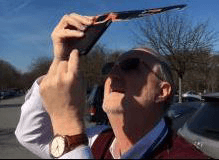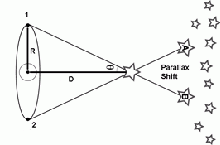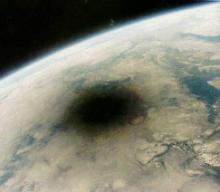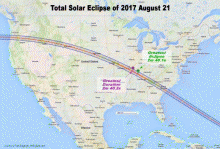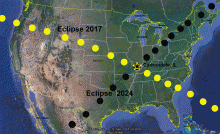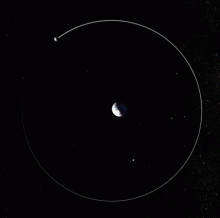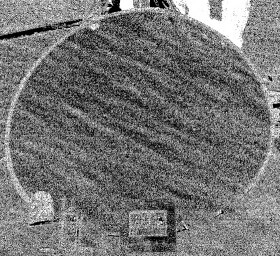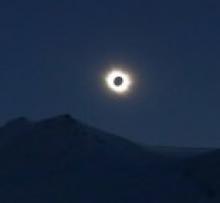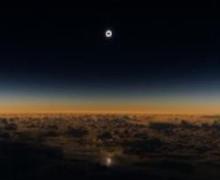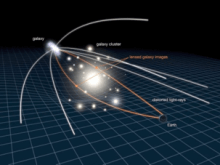Citizen Explorers
Even for the luckiest observers, the total solar eclipse on August 21 will last just under three minutes. Here are some things you might want to do that might increase your enjoyment of this rare and beautiful event!
If you are on the path of totality, notice how rapidly the light across the landscape fades as totality approaches. Do you feel any difference in the way the wind blows, or whether it has gotten a bit chillier? How about animal life in the area, especially birds. Do you sense that they have changed their behavior? In the minute before totality as you are watching the Baily’s Beads light up the limb of the moon, glance around you at a white surface placed horizontally on the ground. Can you see bands of dark shadows move rapidly away from the sun’s direction? If there are trees nearby, can you see the leaves create crescent-shaped sun disks in spaces between the leave’s shadows? You might want to use your smartphone to video the eclipse and capture the conversations from your friends and people nearby during totality. All of these activities will help you put this magnificent event into, not only a natural context, but into a social and human one as well!
If you are not on the path of totality, you may not even notice that an eclipse is happening at all. The sun is so bright that even when only a sliver of it remains during a partial eclipse, you will hardly notice any change in the daytime sunlight at all. Only the fact that you know an eclipse will happen from your location at a specific time will tip you off to this event. Partial eclipses are fun to watch if you have the right solar filters or use a pinhole box, but otherwise they are not in themselves a noteworthy event. However, for a few brief minutes on August 21, you will be part of a large community of millions of observers watching the same astronomical event. You will have access to what people on the path of totality are seeing at exactly the same time. Through social media, you will be able to watch the event provided by the best telescopes and video systems available, which folks along the path of totality may not even bother to watch from their own ring-side seats!
Below is a collection of Citizen Explorer activities that may help you further appreciate solar eclipses, organized in terms of how they may impact the time you have to enjoy this fleeting event.
Go For It! - These projects don’t require more than a few seconds of effort during the eclipse, provided that you have set things up in the hour or so before totality!
- Smartphone Photography of the Eclipse
- Temperature Changes during Totality
- Measuring the Dimming of Daylight
Do These Later - These projects can be done long after the eclipse ends by using archival data, or data available from the many maps of the path of totality and the timing info provided.
- Lunar Distance by Parallax
- X marks the Spot
- Estimating the Mass of Earth
- Lunar Shadow Speed
Experts Only - These projects are ones that veterans of previous total solar eclipses can attempt because this is not the first totality they have witnessed and they are compelled to do some heavy scientific work in setting up their experiment and taking data during the entire period of totality!
- Exploring Shadow Bands
- Lunar Distance from Speed
- Testing General Relativity
Smartphone Photography of the Eclipse
Most of the ‘beauty shots’ you will see related to this eclipse will be taken with professional digital cameras on tripods, or shot through a telescope, but the most common photos you will probably see will be taken by the millions of smartphones used by ordinary people to capture this event. These will generally not look very good with the typical smartphone system, but with a bit of preparation, you will be able to create some stunning pictures! Here are some general guidelines for taking successful smartphone images, followed by some detailed suggestions for inexpensive equipment you will need to really see some impressive details.
Read MoreLunar Distance by Parallax
How far is the moon from where you are standing? Believe it or not, with a little arithmetic you can figure this out for yourself using the parallax method. This method is the same one astronomers use to find out how far stars are from the sun.
Read MoreLunar Shadow Speed
Many people think they can drive fast enough to race the eclipse across the land, but even the fastest jet planes have a hard time keeping up. If you could, you could get an eclipse to last hours instead of only a few minutes! So, how fast does the shadow move from west to east? This project will show you how to find out!
Read MoreLunar Distance from Speed
The speed of the moon’s shadow has to do with how far the moon is from Earth. This problem lets you use a bit of algebra to figure out the distance once you have measured the ground speed of the shadow as it passes over you.
Read MoreX Marks the Spot
The path of the 2017 eclipse from Oregon to South Carolina crosses the paths of other total solar eclipses from 1505 to the present day. This project lets you figure out the crossing points of other historical eclipses by solving simple linear and quadratic equations. Are any of these crossing points close to where you live?
Read MoreEstimating the Mass of Earth
It is amazing but true! By knowing the distance to the moon and the time it takes to orbit once around Earth, you can figure out how much mass Earth has. Similar methods are used by astronomers to ‘weigh’ stars and galaxies in deep space.
Read MoreExploring Shadow Bands
Shadow bands are thin wavy lines of alternating light and dark that can be seen moving and undulating in parallel on plain-colored surfaces immediately before and after a total solar eclipse. Shadow bands have been noted throughout history. What are they? Perhaps you will be the person that figures them out!
Read MoreMeasuring the Dimming of the Daylight
We all know that sunlight fades out during a total solar eclipse, but how dark does it really get? This project lets you measure the brightness changes where you are located, and compare them with daytime, dusk, twilight, and night-time to see which is darkest!
Read MoreObserve the Eclipse from a Passenger Jet!
Although many people plan to be on the path of totality to observe the August 21, 2017 total solar eclipse, there are other opportunities to see this rare event that may surprise you. If you are lucky, you may see it from your passenger jet flight! This project describes how to figure this out.
Read MoreTesting General Relativity
Proposed over 100 years ago by Albert Einstein, this detailed theory of gravity was tested during the 1919 total solar eclipse. This project will show you how it was done, and how you can do this test yourself if you have a telescope, camera and patience!
Read MoreTemperature Change during Totality
When the sun ‘goes away’, things will start to get cool, but by how much? Here is a simple experiment with a thermometer to discover the answer for yourself where you are living. Does the temperature change get larger if you are located on the coast? In the mountains? In the arid midwest?
Read More